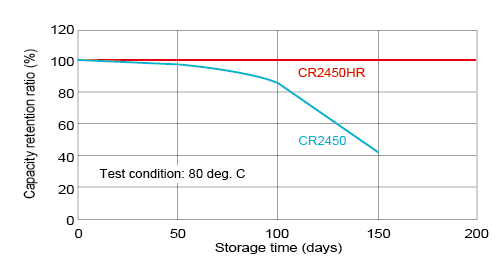Heat Resistant Coin Type Lithium Manganese Dioxide Batteries (CR)
Features
Wide operating temperature range: -40 deg. C to +125 deg. C*
* When using at temperatures exceeding 85 deg. C, please consult Maxell in advance for conditions of use.
Superior leak-resistant characteristics even under high temperature and acceleration.
Can be used even under 2000 G, which is equivalent to driving at 300 km/h.
Even when exposed to high temperature or humid atmosphere for long periods of time, the increase in internal resistance can be suppressed.
UL Recognized Components
The heat resistant coin type lithium manganese dioxide battery is a UL recognized component. (Technician Replaceable)
Recognized model: CR2450HR, CR2050HR, CR2032HR, CR2032HRS
Certification Number: MH12568
Applications
- TPMS (Tire-Pressure Monitoring System)
- ETC (Electronic Toll Collection systems)
- Keyless entry systems
- Seat location sensors
- Communication tags, beacons
- Temperature data loggers (HACCP temperature loggers)
- Logistics tags
- FA instruments (measuring instruments, onboard microcomputers, sensors)
- IoT sensors
Virtual Patent Marking
The list of U.S. patents associated with this product is provided on our Virtual Patent Marking page.
Additional patents may apply in other countries.
Important notice: Technician replaceable component
Maxell Heat Resistant CR (lithium manganese dioxide) batteries are available only for equipment manufacturers as a built-in part. Therefore, Maxell does not supply these batteries for replacement directly to users of equipment. When built-in Heat Resistant CR batteries need to be replaced, please contact your equipment manufacturer. If you are planning to use Maxell Heat Resistant CR batteries in your equipment as a built-in part, please contact Maxell.
Specifications
| Model | CR2032HRS | CR2032HR | CR2050HR | CR2450HR | |
|---|---|---|---|---|---|
| Nominal Voltage (V) | 3 | 3 | 3 | 3 | |
| Nominal Capacity (mAh)*1 | 200 | 200 | 350 | 550 | |
| Nominal Discharge Current (mA) | 0.2 | 0.2 | 0.2 | 0.2 | |
| Operating Temperature Range (deg. C)*2 | -40 to +125 | ||||
| Acceleration Resistance | Max. 3300 G | Max. 2000 G | |||
| Dimensions*3 | Diameter (mm) | 20.0 | 20.0 | 20.0 | 24.5 |
| Height (mm) | 3.2 | 3.2 | 5.0 | 5.0 | |
| Weight (g)*3 | 3.0 | 3.0 | 4.1 | 6.8 | |
| Data Sheets | - | ||||
| Drawings of Batteries with Terminal or Wire Connector |
- | ||||
| Warnings | |||||
- Nominal capacity indicates duration until the voltage drops to 2.0 V when discharged at a nominal discharge current at 20 deg. C.
- When using these batteries at temperatures exceeding 85 deg. C, please consult Maxell in advance for conditions of use.
- Dimensions and weight are for the battery itself, but may vary depending on terminal specifications and other factors.
- Data and dimensions are not guaranteed. For further details, please contact your nearest Maxell office.
- Contents on this website are subject to change without notice.
Construction

Principle and Reactions
The coin type lithium manganese dioxide battery uses manganese dioxide (MnO2) as its positive active material, lithium (Li) as its negative active material and an organic electrolyte.
| Positive reaction : | MnO2+Li++e- → MnOOLi |
|---|---|
| Negative reaction : | Li → Li++e- |
| Total reaction : | MnO2+Li → MnOOLi |
Storage Characteristics under High Temperatures

Little deterioration in capacity due to high storage temperature of 80 deg. C, compared to CR2450 battery.
Storage Characteristics under High Temperature/Humidity

Little deterioration in internal resistance due to high humidity (60 deg. C/90%RH), compared to CR2450 battery.
Discharge Characteristics

Temperature Characteristics

Safety precautions
If misused, this battery may deform, leak (the liquid inside the battery may leak to the outside), generate heat, explode, or ignite.
Since such misuse may cause injury or equipment failure, please be sure to read and observe [Warnings and Cautions].



